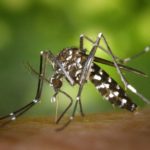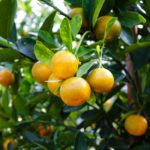M. J. AL-HABIB
Department of Entomology, Sylhet Agricultural University, Sylhet-3100, Bangladesh.
M. A. R. CHOUDHURY
Department of Entomology, Sylhet Agricultural University, Sylhet-3100, Bangladesh.
M. A. MALEQUE
Department of Entomology, Sylhet Agricultural University, Sylhet-3100, Bangladesh.
B. DAS
Department of Entomology, Sylhet Agricultural University, Sylhet-3100, Bangladesh.
A. ULLAH KHAN
Department of Entomology, Sylhet Agricultural University, Sylhet-3100, Bangladesh.
ABSTRACT: The experiment was carried out during winter 2019 in the field of Agricultural Training Institute, Sylhet, Bangladesh to find out the effective ecofriendly insecticides to control fruit borer Helicoverpa armigera Hub. attacking tomato plants. The study was conducted with three treatments viz., Bacillus thuringiensis @ 2.0 mg L-1, Spinosad 45 SC@ 0.4ml L-1, Abamectin 1.8 EC @ 1.2 ml L-1 of water and untreated control. Results revealed that the number of healthy fruits increased by 72.85% over control due to spraying of Spinosad 45 SC and it was followed by Bacillus thuringiensis (32.78%) and Abamectin 1.8 EC (26.82%). The highest number of healthy fruits (274.00) was harvested from Spinosad 45 SC treated plot and the lowest number (100.6) from untreated control plot. The yield in different treatments ranged from 12.43 -17.58 t ha-1. The highest adjusted net return (Tk. 225800.70) and BCR (Tk. 8.74) were obtained from Spinosad 45 SC treated plot. The second highest BCR of 8.70 was calculated from Bacillus thuringiensis (Bt) treated plot and the lowest BCR of 5.02 was found in Abamectin 1.8 EC treated plot. All the treated insecticides reduced the infestation of fruit borer, but Spinosad 45 SC was found most effective.
Keywords: Helicoverpa armigera, Solanum lycopersicum, yield, benefit-cost ratio, biorational and microbial
REFERENCES
ABDELGALEIL, S. A., EL-BAKARY, A. S., SHAWIR, M. S. & RAMADAN, R. 2015. ‘Efficacy of various insecticides against tomato leaf miner, Tuta absoluta, in Egypt’, Appl. Biol. Res. 17(3), 297–301. doi:10.5958/0974- 4517.2015.00042.7
AHMED, S. 2002. Genetics of fruit set and related traits in tomato under hot humid conditions. Ph.D. Thesis. Bangabandhu Sheikh Mujibur Rahman Agricultural University. pp. 44-180.
ALAM, S. N., RAHMAN, AKMZ. & DUTTA, N. K. 2007. Performance trials of different exotic tomato lines against ToLCV and whitefly. Annual Report, Division of Entomology, Bangladesh Agricultural Research Institute, Joydebpur, Gazipur 1701. p. 163.
DHANDAPANI, N, SHELKAR U. R. & MURUGAN M. 2003. Bio-intensive pest management (BIPM) in major vegetable crops: An Indian perspective. Food, Agric. Environ. 12, 70-73.
DURAIRAJ, C., SUBBARATNAM G. V., SINGH T. V. K. & SHANOWER T. G. Helicoverpa in India: Spatial and Temporal Dynamics and Management Options in management (In: Heliothis/Helicoverpa Management: Emerging Trends and Strategies for Future Research, the book edited by H C Sharma). pp. 91-117.
FAO.1988. Production Year book, Food and Agricultural Organization of the United Nation, Rome, Italy. 42, 190-193.
FAOSTAT. 2018. Bangladesh: Tomatoes, production quantity. Food and Agriculture Organization, Rome, Italy.
FAQIRI, M. & KUMAR, A. 2016. Management of tomato fruit borer (Helicoverpa armigera (Hubner) by chemical insecticides and neem products. Int. Multidiscip. Res. J. 3, 82-85.
FITT, G.P. 1989. The ecology of Heliothis species in relation to agroecosystems. Annu. Rev. Entomol. 34, 17-52.
ISLAM, M. K., HOWLADER M. T. H. & AHMED, K. S. 2020. Management of Helicoverpa armigera (Hubner) infesting tomato using biopesticides under field condition and its effect on tomato yield. Journal of the Bangladesh Agricultural University. 18(1), 1-5. doi: 10.5455/ JBAU.93660ISSN1810-3030
KUMAVAT, S. D. AND CHAUDHARI, Y. S. 2013. Lycopene and its role as prostate cancer chemo preventive agent. Intl. J. Res. Pharma. Chem. 3(3), 545- 551.
LYNCH, J. M. 1990. Fungi as antagonists in: New directions in biological control: Alternatives for suppressing agricultural pests and diseases, Liss, New York.
MACLNTYRE, A. N. N., N. ALLISON & D. R. PENMAN. 1989. Insecticides: issues and options for New Zealand Ministry of Environment, Wellington, New Zealand.
MEHRVAR, A. 2009. Persistence of different geographical isolates of Helicoverpa armigera nucleopolyhedrovirus in two types of soils under different conditions. J. Biol. Sci. 9(3), 264-267.
MUSTAFIZ, S. S. B., CHOWDHURY, M. T. I. & AKTER, A. 2015. Efficacy of some botanicals in controlling fruit borer (Heliothis armigera) in tomato. Academic Journal of Entomology. 8(3), 140-149.
MUTHUKUMARAN, N. & SELVANARAYANAN, V. 2013. Studies on influence of microbial inoculants on feeding preference of fruit worm towards tomato accessions. In: Natl, S. (Ed.). On golden thoughts on current microbial research. Book of abstracts, Department of Micorbiology, Annamalai University, Tamil Nadu, India.
NASEBY, D. C., PASCUAL J. A. & LYNCH J. M. 2000. Effect of biocontrol strains of Trichoderma on plant growth, Pythium ultimum population, soil microbial communities and soil enzyme activities. J. Appl. Microbiol. 88(1), 161-169.
NATH, R. K., BEGUM, K. H., BRAHMA, S. & SARMA, R. 2020. Integrated pest management as a tool in influencing growth, yield and economics of tomato. J. Pharma. Photochem. 9(5), 250-252.
PAREEK, P. L. & BHARGAVA, M. C. 2003. Estimation of avoidable losses in vegetables caused by borers under semi-arid condition of Rajasthan. Insect Environ. 9, 59-60.
RAHMAN, M. A., ALAM, M. S., AHMAD, Q. N., KHAN, M. A. I. & ABDULLAH- A.M. 2003. Genetic Analysis on yield and its component traits of tomato (Lycopersicon esculentum Mill.). A Scientific Journal of Krishi Foundation. The Agriculturists. 1(1), 21-26.
RASHID, M. A. & SINGH. D. P. 2000. A Manual on Vegetable Seed Production in Bangladesh. AVRDC-USAID-Bangladesh Project. HRC. pp. 21-86.
RASHID, M. M. 1993. Shabji Baggan (In Bengali). Bangla Academy, Dhaka. Pp. 192-219.
SIDDE GOWDA, D. K., YELSHETTY, S. & PATIL B. V. 2003. Spinosad 45 SC: An effective insecticide against pigeonpea fruit borer, Helicoverpa armigera (Hubner). Pestology. 27, 21-22.
SRDI (SOIL RESOURCES DEVELOPMENT INSTITUTE). 2018. Sylhet By-pass Road, Chandipool Point, Pirijpur, Sylhet-3100, Bangladesh.
TALEKAR, N. S., OPEN R. T. & HANSON, P. 2006. Helicoverpa armigera management: A review of AVRDC’s research on host plant resistance in tomato. Crop Prot. 5, 461-467.
WAIGANJO, M. M., WABULE, N. M., NYONGESA, D., KIBAKI, J. M., ONYANGO, I., WEPUKHULU, S. B. & MUTHOKA, N. M. 2006. Tomato production in Kirinyaga district, Kenya. A baseline Survey report. pp. 3-4.
ZALUCKI, M. P., DAGLISH, G., FIREMPONG, S. & TWINE, P. 1986. The biology and ecology of Heliothis armigera (Hubner) and H. punctigera Wallengren (Lepidoptera: Noctuidae) in Australia: What do we know? Aust. J. Zool. 34, 779-814.







